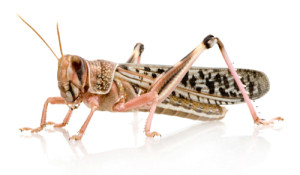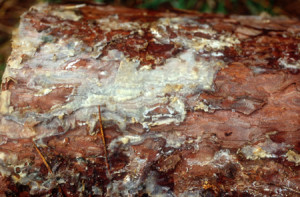WALNUT CREEK, CA—The U.S. Department of Energy (DOE) Joint Genome Institute (JGI) has selected 71 new genomic sequencing projects for its 2010 Community Sequencing Program (CSP)—a targeted sampling of the planet’s biodiversity—to be characterized for bioenergy, climate, and environmental applications.
JGI’s Community Sequencing Program is the largest genomic sequencing effort in the world focused on nonmedical organisms, enabling scientists from universities and national laboratories to probe the hidden world of microbes and plants to tap nature’s ingenuity for innovative solutions to the nation’s major challenges in energy, climate, and environment. The program is supported by the Office of Biological and Environmental Research in the DOE Office of Science.

The desert locust can eat the equivalent of its body mass in a day, but its unclear whether the insect
or the microbes in its gut are breaking down the lignocellulose. Photo from istockphoto.
“The information we generate from these projects promises to improve the clean, renewable energy pathways being developed now as well as lend researchers more insight into the global carbon cycle, options for bioremediation, and biogeochemical processes,” said DOE JGI Director Eddy Rubin. “In translating DNA sequence data into biology, we generate valuable science that improves our understanding of the complex processes that support life on the planet, or imperil it.”
The DOE JGI’s recent transition to new sequencing technologies has increased its sequencing throughput almost five times, from over 60 billion nucleotides allocated for CSP projects last year, to about a third of a trillion nucleotides for the CSP 2010. The projects approved for the program involve organisms that come from the Arctic up north to New Zealand down south. Selection was based on scientific merit as determined by peer review and relevance to DOE missions in bioenergy, climate science, or bioremediation.
Many of the projects are bioenergy-related. A key goal in the quest for cost-effective cellulosic biofuels (or biofuels from nonfood plant fiber) is the search for more effective enzymes to break down plant fiber into sugars that can be converted to fuels. Among the selected sequencing projects related to this search are sequencing of the gut wall and microbial community of the desert locust, notorious since Biblical times for its capacity to swarm and destroy whole fields of crops; microbial communities in the guts of 11 plant-digesting insects from New Zealand and 3 termites from Australia; and a white rot fungus that attacks plants known as Phlebiopsis gigantea.

P. gigantea found fruiting on a red pine log in a northern Minnesota forest, where the fungus, an aggressive saprophyte, is commonly found on downed logs or cut timber. Photo courtesy of Robert A. Blanchette (University of Minnesota)
Another major goal of bioenergy research is the development of more effective fermentation of plant-derived sugars into liquid fuels. One project focuses E. coli mutants that have been specifically developed to have higher alcohol tolerances, which means they can produce alcohols such as isobutanol and propanol whose higher energy densities are closer to that of gasoline.
In addition, sequencing of a member of the mustard family known as Boechera holboelli may provide insights into better methods of breeding crops, including those used for biofuel feedstocks.
Other projects are aimed at better understanding climate change and focus on organisms in climate change-stressed environments. One project looks at microbes trapped in the Alaskan permafrost, which can help in ongoing study of the region’s response to climate change in terms of water quality and carbon capture. Another involves microbial genomes collected from the Atlantic Ocean’s mesopelagic or “twilight zone” near South America.
Still other sequencing efforts are focused on organisms that could provide insights into environmental remediation, a major mission at DOE legacy sites. Included among these is the sequencing of fire moss (Cereus purpureus), the largest 2010 CSP project, with a genome of 240 million nucleotides. Fire moss is often found in disturbed areas such as soils contaminated with heavy metals. Other bioremediation projects include a novel isolate of a freshwater bacterium from the Siderocapsaceae family that can remove manganese contaminants and Sphingobium chlorophenolicum, a bacterium that breaks down PCP, a toxic and carcinogenic pollutant found in contaminated areas such as Environmental Protection Agency Superfund sites.
The breakdown of the 71 approved projects is: 15 eukaryote (organisms whose cells contain complex structures enclosed within membranes) genomes; six eukaryotes to be resequenced using next generation short-read sequencing technologies; two expressed gene sequencing or “transcriptomes”; 20 microbes; 20 metagenomes (microbial communities); and 8 bacteria to be resequenced. Reference genomes for these bacterial isolates already exist, but resequencing particular isolates allows researchers to better understand bacterial community structure or gene functions.
DOE JGI will employ a variety of sequencing methods, ranging from whole-genome shotgun sequencing that produce high-quality draft sequences, to next generation technologies that can generate millions of sequence reads per run, to single cell sequencing techniques that allow access to genomes when only minute quantities of DNA are available. Beyond sequencing, DOE JGI offers assembly, annotation, and genome analysis services for all approved CSP projects.
See the complete list of CSP 2010 sequencing projects.
Established in 2005, the Community Sequencing Program (CSP) provides the scientific community at large with free access to high-throughput sequencing at DOE JGI for projects of relevance to DOE missions. Sequencing projects are chosen based on scientific merit — judged through independent peer review — and relevance to issues in bioenergy, global carbon cycling and biogeochemistry.
The U.S. Department of Energy Joint Genome Institute, supported by DOE’s Office of Science, is committed to advancing genomics in support of DOE missions related to clean energy generation and environmental characterization and cleanup. DOE JGI, headquartered in Walnut Creek, Calif., provides integrated high-throughput sequencing and computational analysis that enable systems-based scientific approaches to these challenges.